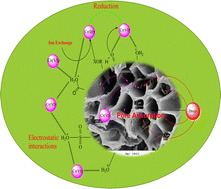Remediation of hexavalent chromium and pharmaceuticals from aquatic environments by employing an oxygen-doped porous carbon adsorbent and its antifungal activity†
Abstract
The existence of emerging pollutants, including hexavalent chromium and pharmaceuticals in water, presents a severe hazard since the degree of their effects on the ecology and public health remains unknown. To develop extremely excellent adsorbents for the elimination of chromium and pharmaceuticals, an oxygen-doped biomass-derived carbon (AC) was produced by the direct carbonatization of Doronicum pardalianches L, accompanied by alkali activation and oxygen doping treatment, to explore their application in the adsorption of hexavalent chromium and pharmaceuticals in aquatic systems. The morphological analysis has shown that AC had an extensive pore shape with tiny grains, greater bumpiness, and rich oxygen functionality. Adsorption studies revealed that AC was highly efficient because of its excellent surface area (1397 m2 g−1), total pore volume (0.64 cm3 g−1) value, pore size (18 Å) and rich oxygen functionality. The pseudo-second-order model was superior and appropriate. To anticipate the experimental data, the Langmuir model best matches the equilibrium data with the optimum adsorption capacities of 156.9, 248.3, 216.1, and 201.7 mg g−1 for hexavalent chromium, acetaminophen, ibuprofen, and Orudis KT, respectively. According to the kinetic and isotherm analysis, the adsorption mechanism was jointly composed of the physiochemical reactions of Cr(VI) ions on the monolayer and homogeneous adsorption sites of AC, whereas the adsorption of pharmaceuticals occurs only via physisorption. The remediation effectiveness of 20 mg L−1 Cr(VI) concentration by 12 g L−1 AC concentration of >99% was achieved at pH = 3, mixing speed = 250 rpm, and contact time = 25 min. The removal effectiveness of 50 mg L−1 pharmaceutical concentration was studied by AC dosages of 0.75 g L−1, 0.38 g L−1, and 1.2 g L−1, with maximum pH values of 8, 6, and 4 for acetaminophen, ibuprofen, and Orudis KT, respectively. Additionally, the flower-derived adsorbent was very effective in treating a simulated drug and Cr(VI) effluents, eliminating 98% of Cr(VI) and pharmaceutical substances. Furthermore, it was found that AC in combination with silver displayed excellent antifungal activity, as compared to Fluconazole. As a result, the material developed in this study has inherent qualities that make it an excellent adsorbent for use in the remediation of Cr(VI) and pharmaceutical pollutants found in industrial wastewater.



 Please wait while we load your content...
Please wait while we load your content...